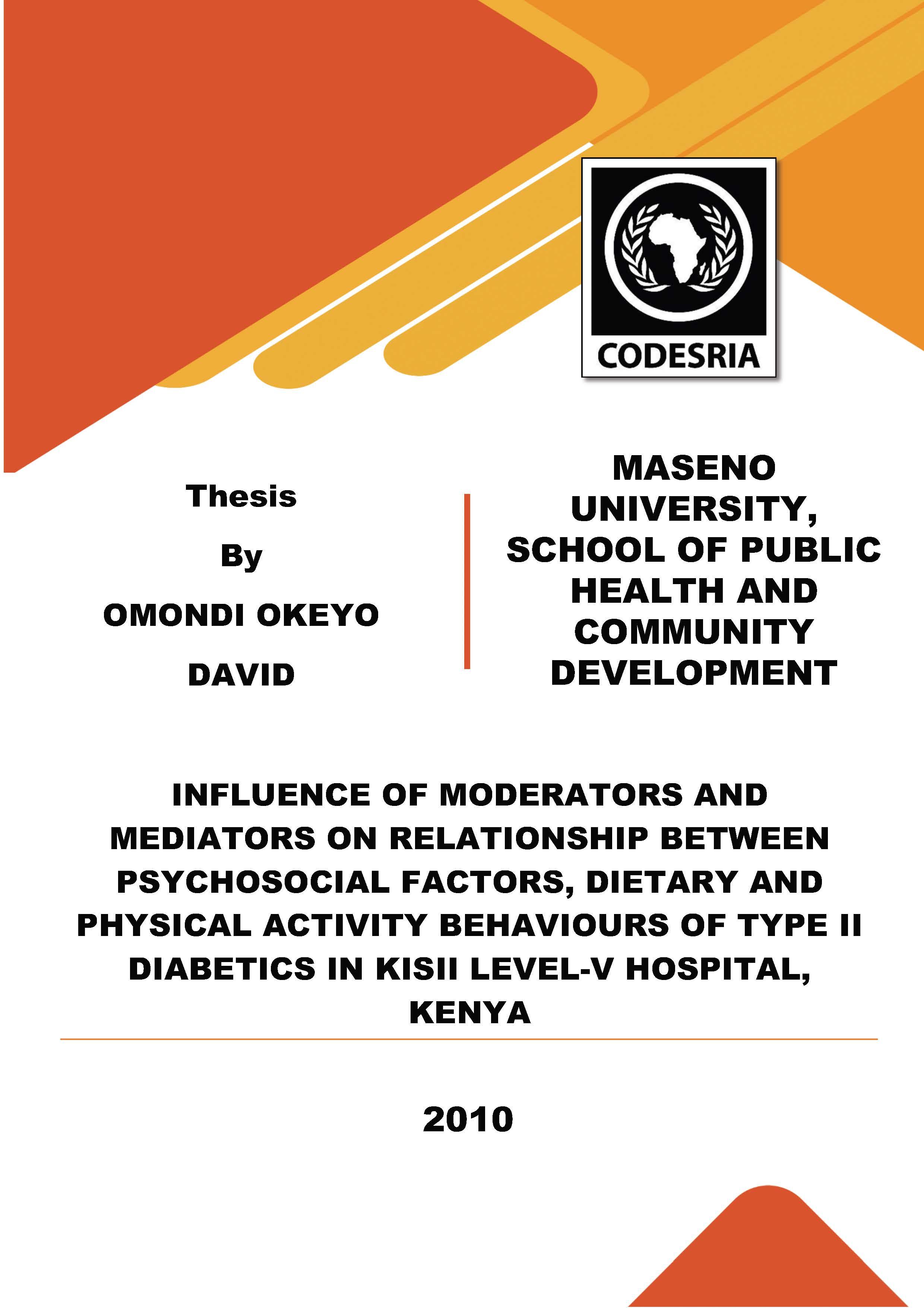INFLUENCE OF MODERATORS AND MEDIATORS ON RELATIONSHIP BETWEEN PSYCHOSOCIAL FACTORS, DIETARY AND PHYSICAL ACTIVITY BEHAVIOURS OF TYPE II DIABETICS IN KISII LEVEL-V HOSPITAL, KENYA
Keywords:
MODERATORS, MEDIATORS, PSYCHOSOCIAL FACTORS, KENYASynopsis
Despite efforts to promote healthy diet or adequate physical activity among Type II diabetics in most clinics in Kenya the incidence, progression and severity still persit, possibly because of non-patient input approaches used. Motivation theories have been developed for health educators attending to Type II diabetics to aid in promotion of healthy dietary and physical activity practices, however, this approach has not been welcome in most diabetic clinics in Kenya. There was a crucial need to emperically develop a mental health tailored communicaion model that could be used to promote healthy dietary and physical activity among Type II diabetics. The main purpose of this study was to establish the influence of moderators and mediators on
relationship between psychosocial factors, dietary and physical activity behaviours of Type II diabetics in Kisii level-V hospital in Kenya. This was broadly achieved by testing the predictive power of the Theory of Planned Behaviour (TPB) and newly developed versions within dietary practice and physical activity domains. The study was conducted in Kisii Level-V hospital chosen on the basis that it had more advanced and well organized diabetic programmes with comparatively high number of regular Type II diabetics compared to other hospitals in Nyanza Province. Sequential Mixed Methods Design (SMMD) involving qualitative study (phase 1), questionnaire development (phase 2) and quantitative study (phase 3) was adopted since it is recommended for grounded theory investigations. Data was collected between the month of June and November, 2009 during which all the three phases of the study design were covered. Using a Cross-Model approach two different cohorts of patients participated in the study comprising of 237 for the dietary survey and 230 patients for physical activity survey. Each cohort had a population frame of 400 Type II diabetic patients. Focus Group Discussion guides and structured questionnaires were used to collect data on selected variables. Questionnaires were statistically tested for reliability and construct validity using Cronbach Alpha and Exploratory Factor Analysis. Qualitative data was analyzed using constant comparative approach for grounded
theory method while Structural Equation Modelling in Analysis of Moments Structures (AMOS) was used to analyze quantitative data. Preliminary findings revealed that over 90 percent of the items in the two questionnaires used were reliable and valid. Main findings revealed that the Theory of Planned Behaviour holds among the Type II diabetics and within dietary and physical
activity behaviours based on the fit indices chosen for the analysis. Qualitative results generated three new versions of the theory: planned behaviour knowledge theory; planned behaviour health belief theory and planned behaviour maintenance and control theory, which fitted the data acceptably within dietary and physical activity behaviours among the Type II diabetics based on the common fit indices used during quantitative analysis. However, the planned behaviour knowledge theory failed fit the data acceptably within physical activity behaviour. These new generations of planned behaviour theories were comparatively superior to the traditional Theory of Planned Behaviour. In the pre-intention phase knowledge was found to be a mediator and perceived susceptibility; perceived severity; perceived benefits and cues to action were moderators that predicted intention within the TPB model applied to dietary and physical activity behaviour. In the post-intention phase action control, action plan and maintenance self efficacy were mediators between intention and dietary or physical activity behaviour. The original theory and new generation were then used to develop a mental health tailored communication model which includes a network of patients’ related factors and is proposed for adoption for diabetic patients’ education by health professionals to promote healthy dietary practice and physical activity among Type II diabetics within diabetic clinic in Kisii Level-V hospital and other clinics in Kenya.
Downloads
References
Lysack, C.L. & Krefting, L. (1994). Qualitative methods in field research: An Indonesian experience in community based practice. The Occupational Therapy Journal of Research, 14(20): 93-110
Maddux, J.E. & Rogers, R.W. (1983). Protection motivation and self-efficacy: A revised theory of fear appeals and attitude change. Journal Experimental Social Psychology, 19: 469-479.
McCormic-Brown, K. (1999). Health Belief Model. (Accessed on December 3, 2009). http//hsc.usf.edu/~kmbrown/Health_Belief_Model_Overview.htm.
McIver, J. P. & Carmines, E. G. (1981). Unidimensional scaling. Thousand Oaks, CA: Sage Ministry of Health (1996). Report on Non-Communicable Diseases. Ministry of Health Headquarters, Nairobi.
Morgan, D. (1998). Practical Strategies for combining qualitative and quantitative methods: Application to health research. Qualitative Health Research, 8(2): 362-376.
Mugnaini, R., Packer, A.L. & Meneghini, R. (2008). Comparison of scientists of the Brazilian Academy of Sciences and of the National Academy of Sciences of the USA on the basis of the h-index. Brazilian Journal of Medical and Biological Research, 41(4): 258-262.[Online]. Available:{http://www.scielo.br/scielo.php?script=sci_arttext&pid=S0100879X2008000400001&lng=enes&nrm=iso&tlng=enes } (Accessed on May 16, 2009).
Mullen, P. D., Hersey, J. & Iverson, D. C. (1987). "Health Behaviour Models Compared." Social Science and Medicine, 24: 973–981.






